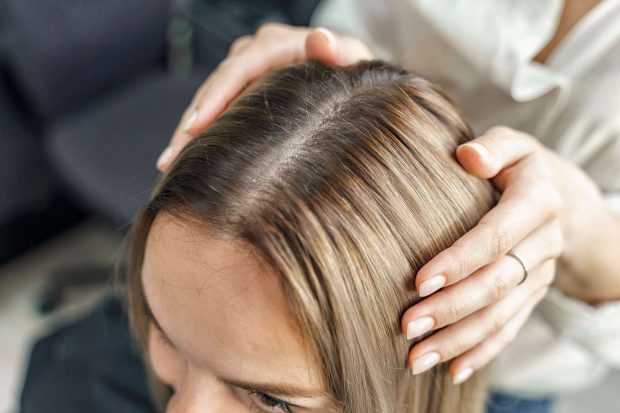One of the most common conditions worldwide is hair loss. Many men will experience some form of hair loss, potentially even before turning 35. However, don’t let the statistics get you down in the doldrums. If you’ve discovered you’re losing hair, there are many proactive steps you can take. Keep reading to understand the condition, its causes, and what you can do to treat and cope with it.

What Causes Hair Loss?
Hair loss is a tricky condition. It can have many causes, and sometimes it can be hard to figure out which one has affected you. Here are four of the most common causes of hair loss:
Stress
You might be surprised to hear that stress doesn’t just affect you mentally. Being highly stressed for lengthened periods of time can lead to a variety of health conditions and illnesses. For one, your immune system is often weakened, making you more susceptible to sickness. Alopecia areata is one hair loss condition caused by the immune system attacking healthy hair cells. This condition is marked by hair falling out in large patches.
Another stress-induced type of hair loss is called telogen effluvium. This condition is temporary, but can disguise itself as male pattern baldness. When the body undergoes severe stress, the hair follicles can respond by shutting down. When this occurs, the follicles shrink up and won’t produce any more hair, and what was there will fall out.
Hormonal Imbalance
Like stress, hormones can also affect various parts of the body. Having too much or too little can cause a related part of the body to do some strange things. One such hormone is dihydrotestosterone (DHT), a male sex hormone. When the body overproduces DHT, the built-up hormone clings to the hair follicles. As a result, the follicles shrink and stop growing hair. This is one of the most common causes of male pattern baldness, as it usually affects follicles at the crown and hairline.
Mistreatment
Treating your body well is an important part of taking care of yourself, and that includes your hair. Using heated styling tools, like a hair dryer or straightener, will damage your hair over time. Wearing thick gels and products with sulfates also can weaken your hair and sometimes dry out the scalp. Tight hairstyles, like updos and braids, can tug at the scalp and loosen the follicles, leading to a receding hairline.
Using lightweight products and moisturizing shampoos will keep your hair healthier and stronger. You should be applying hydrating conditioners every time you wash your hair, as well. Restoring moisture after scrubbing the scalp clean is essential to keep follicles healthy and hair growing.
Diet
Similar to how you take care of the outside of your body, the inside should be given good treatment too. When your body isn’t getting enough of the right nutrients, your hair can be negatively impacted. Certain vitamins, like biotin and vitamin A, are directly related to hair health. Deficiencies in these can result in hair loss and brittle hair that won’t grow. Making sure you get enough nutrients can decrease your likelihood of experiencing hair loss.
What Can You Do?
So now you know a few of the most common causes of hair loss. However, how can you go about trying to treat these issues? There are a few ways to tackle this condition, starting from least invasive to most invasive.
Medication
There are a couple different types of medicine that are proven to be very effective against hair loss. Minoxidil is a stimulating drug, meaning it spurs the follicles to begin new growth. It improves blood flow and reverses follicle shrinkage. It’s most commonly used as a topical gel, cream, or serum twice a day. Usually around four to six months, with consistent use, you’ll be able to see steady growth and notice a difference in your hair.
Another medicine that’s prescribed often is finasteride. This medication works best for conditions like male pattern baldness caused by too much DHT. Finasteride is a DHT blocker that stops the overproduction of this hormone. Once the amount of DHT lessens in your body, your follicles can start growing hair again. Finasteride is usually prescribed as a pill, but you can also find it as a topical mixed with minoxidil for twice the impact.
Steroid Injections
When it comes to treating tricky cases of hair loss, injections might be an effective solution for you. These are most often used for conditions like alopecia, where the immune system is the root cause behind the hair loss. The injections can suppress the immune system’s attacks against healthy cells, restoring your hairline.
Corticosteroids are one of the most common types of scalp injections for hair loss. These steroids work against the overactive immune system to allow hair to grow again. The medication is injected directly into the affected regions, and usually takes a few rounds. Injections can be repeated every four to six weeks, and can take one to two months to show results.
Hair Transplants
Hair transplants work by grafting small pieces of scalp with healthy follicles into the bare patches. These healthy follicles are usually taken from somewhere else on the scalp, like the back of the head. These pieces of skin are then implanted into the scalp where you want hair to grow again. Transplants can take up to a year before permanent results can be seen, depending on if your body accepts the grafts. However, this is the most permanent treatment out there, so it’s worth considering.
Be Positive and Accepting
Even though it seems like a big deal, hair loss isn’t necessarily a life sentence to unhappiness. Your confidence doesn’t have to be rooted in your hair. Accepting the reality of your hair’s situation is the first step to moving forward despite this setback. Treatment is usually pretty effective, as well. However, even if your hair doesn’t return to how it used to look, remember that you’re more than just your hair. Know your worth and you’ll be rocking whatever style your hair becomes.



